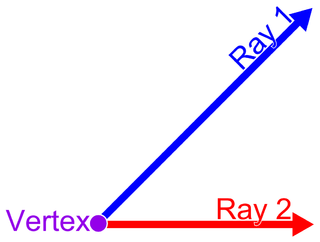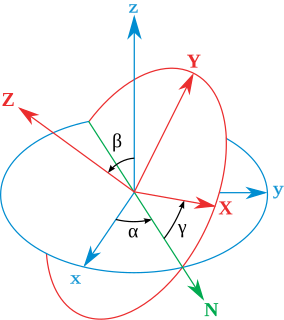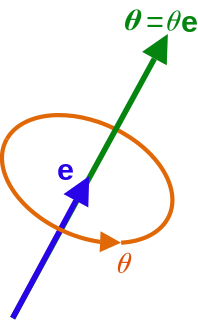
In Euclidean geometry, an angle is the figure formed by two rays, called the sides of the angle, sharing a common endpoint, called the vertex of the angle. Angles formed by two rays lie in the plane that contains the rays. Angles are also formed by the intersection of two planes. These are called dihedral angles. Two intersecting curves define also an angle, which is the angle of the tangents at the intersection point. For example, the spherical angle formed by two great circles on a sphere equals the dihedral angle between the planes containing the great circles.

A pipette is a laboratory tool commonly used in chemistry, biology and medicine to transport a measured volume of liquid, often as a media dispenser. Pipettes come in several designs for various purposes with differing levels of accuracy and precision, from single piece glass pipettes to more complex adjustable or electronic pipettes. Many pipette types work by creating a partial vacuum above the liquid-holding chamber and selectively releasing this vacuum to draw up and dispense liquid. Measurement accuracy varies greatly depending on the instrument.

In physics, angular frequencyω is a scalar measure of rotation rate. It refers to the angular displacement per unit time or the rate of change of the phase of a sinusoidal waveform, or as the rate of change of the argument of the sine function. Angular frequency is the magnitude of the vector quantity angular velocity.

The Euler angles are three angles introduced by Leonhard Euler to describe the orientation of a rigid body with respect to a fixed coordinate system.
The Faraday effect or Faraday rotation, sometimes referred to as the magneto-optic Faraday effect (MOFE), is a physical magneto-optical phenomenon. The Faraday effect causes a polarization rotation which is proportional to the projection of the magnetic field along the direction of the light propagation. Formally, it is a special case of gyroelectromagnetism obtained when the dielectric permittivity tensor is diagonal.
Strikes are offensive moves in professional wrestling, that can sometimes be used to set up an opponent for a hold or for a throw. There are a wide variety of strikes in pro wrestling, and many are known by several different names. Professional wrestlers frequently give their finishers new names. Occasionally, these names become popular and are used regardless of the wrestler performing the technique.
The term "biceps curl" refers to any of a number of weight training exercises that primarily targets the biceps brachii muscle. It may be performed using a barbell, dumbbell, resistance band, or other equipment.
In physics, the gyromagnetic ratio of a particle or system is the ratio of its magnetic moment to its angular momentum, and it is often denoted by the symbol γ, gamma. Its SI unit is the radian per second per tesla (rad⋅s−1⋅T−1) or, equivalently, the coulomb per kilogram (C⋅kg−1).
Revolutions per minute is the number of turns in one minute. It is a unit of rotational speed or the frequency of rotation around a fixed axis.
Tatsia ("sieve") is a Cypriot traditional dance, performed with a sieve.
Wrist spin is a type of bowling in the sport of cricket. It refers to the cricket technique and specific hand movements associated with imparting a particular direction of spin to the cricket ball. The other spinning technique, usually used to spin the ball in the opposite direction, is finger spin. Wrist spin is bowled by releasing the ball from the back of the hand, so that it passes over the little finger. Done by a right-handed bowler, this imparts an anticlockwise rotation to the ball, as seen from the bowler's perspective; a left-handed wrist spinner rotates the ball clockwise.
An armlock in grappling is a single or double joint lock that hyperextends, hyperflexes or hyperrotates the elbow joint or shoulder joint. An armlock that hyper-extends the arm is known as an armbar, and it includes the traditional armbar, pressing their elbow into your thigh, and the triangle armbar, like a triangle choke, but you press their elbow into your thigh. An armlock that hyper-rotates the arm is known as an armcoil, and includes the americana, kimura, and omaplata. Depending on the joint flexibility of a person, armcoils can either hyper-rotate only the shoulder joint, only the elbow joint, or both the elbow joint and shoulder joint. Generally, armcoils hurt more than armbars, as they attack several joints at the bone and muscle.

Rotation around a fixed axis is a special case of rotational motion. The fixed-axis hypothesis excludes the possibility of an axis changing its orientation and cannot describe such phenomena as wobbling or precession. According to Euler's rotation theorem, simultaneous rotation along a number of stationary axes at the same time is impossible; if two rotations are forced at the same time, a new axis of rotation will appear.

Liquid-mirror telescopes are telescopes with mirrors made with a reflective liquid. The most common liquid used is mercury, but other liquids will work as well. The liquid and its container are rotated at a constant speed around a vertical axis, which causes the surface of the liquid to assume a paraboloidal shape. This parabolic reflector can serve as the primary mirror of a reflecting telescope. The rotating liquid assumes the same surface shape regardless of the container's shape; to reduce the amount of liquid metal needed, and thus weight, a rotating mercury mirror uses a container that is as close to the necessary parabolic shape as possible. Liquid mirrors can be a low-cost alternative to conventional large telescopes. Compared to a solid glass mirror that must be cast, ground, and polished, a rotating liquid-metal mirror is much less expensive to manufacture.

A kip-up is an acrobatic move in which a person transitions from a supine, and less commonly, a prone position, to a standing position. It is used in activities such as breakdancing, gymnastics, martial arts, professional wrestling, and freerunning, and in action film fight sequences.

The radian per second is the SI unit of angular velocity, commonly denoted by the Greek letter ω (omega). The radian per second is also the SI unit of angular frequency. The radian per second is defined as the change in the orientation of an object, in radians, every second.

In mathematics, the axis–angle representation of a rotation parameterizes a rotation in a three-dimensional Euclidean space by two quantities: a unit vector e indicating the direction of an axis of rotation, and an angle θ describing the magnitude of the rotation about the axis. Only two numbers, not three, are needed to define the direction of a unit vector e rooted at the origin because the magnitude of e is constrained. For example, the elevation and azimuth angles of e suffice to locate it in any particular Cartesian coordinate frame.
In mathematics and physics, the plate trick, also known as Dirac's string trick, the belt trick, or the Balinese cup trick, is any of several demonstrations of the idea that rotating an object with strings attached to it by 360 degrees does not return the system to its original state, while a second rotation of 360 degrees, a total rotation of 720 degrees, does. Mathematically, it is a demonstration of the theorem that SU(2) is simply connected. To say that SU(2) double-covers SO(3) essentially means that the unit quaternions represent the group of rotations twice over. A detailed, intuitive, yet semi-formal articulation can be found in the article on tangloids.
The rear delt raise, also known as the rear deltoid raise, or rear shoulder raise is an exercise in weight training. This exercise is an isolation exercise that heavily works the posterior deltoid muscle. The movement is primarily limited to the two shoulder joints: the glenohumeral joint and the scapulothoracic joint. Scapular movement will also cause movement in the sternoclavicular joint and acromioclavicular joint. If the elbow bends during the extension exercises, it gravitates into a rowing motion.
Hasta Vinyasas are a set of yoga vinyasas which primarily involve movement of the arms.







